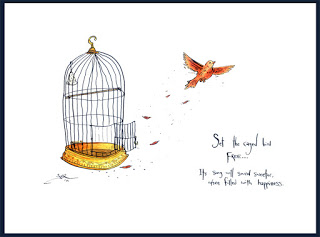updated 4/12/16
PROJECT TWO: SAVING ANIMALS THROUGH WRITING
250 POINTS OR MORE


Why this assignment? It is not only experiential and service learning, it strengthens the foundation of ethics, the sympathetic imagination, which enhances in turn enhances the ultimate ethical virtue, compassion.
NEWS STORIES ABOUT THIS ASSIGNMENT
===================================================================
P2 consists of two sections
[1] P2A THE EXPERIMENT: TRYING TO EXTEND SYMPATHETIC IMAGINATION TO ANOTHER BEING [at least 700 WORDS ]
[2]P2B: EVALUATING THE RESULTS OF THE EXPERIMENT [at least 700 WORDS ]
>===================================================================
WHAT IS DUE: an essay in blog format* of at least fourteen-hundred words that must include multimedia (at least one video and three stills of the dog or cat), at least the two required citations, and endnotes (*footnotes become endnotes). Must include the animal's point of view about physical confinement, loss of freedom, etc. Must be acceptable college-level writing. Must end with accurate word counts both with and without quotations.
AT THE VERY TOP OF THE FIRST PAGE MUST APPEAR IN LARGE TYPE THE THREE RUBRICS ASSIGNED BY THE INSTRUCTOR FOR IMPROVEMENT IN P2,
REQUIREMENT FOR SECTION ONE:
YOU MUST INCLUDE THE ANIMAL'S POINT OF VIEW ABOUT LOSS OF FREEDOM, ABOUT THE ANIMAL'S PHYSICAL CONFINEMENT, etc. Substantial bonus points for not only including passages from Kafka's Report to the Academy (pp. 1145-1151) especially this section, but also revealing insights into the meaning of this section.
[Wikipedia plot summary of Kafka's story: "The narrator, speaking before a scientific conference, describes his former life as an ape. His story begins in a West African jungle, in which a hunting expedition shoots and captures him. Caged on a ship for his voyage to Europe, he finds himself for the first time without the freedom to move as he will. Needing to escape from this situation, he studies the habits of the crew, and imitates them with surprising ease; he reports encountering particular difficulty only in learning to drink alcohol. Throughout the story, the narrator reiterates that he learned his human behavior not out of any desire to be human, but only to provide himself with a means of escape from his cage]
REQUIREMENTS FOR SECTION TWO:
DO NOT just rehearse your visit, or just provide an account of it. EVALUATE the possibility of extending the sympathetic imagination, empathy, sympathy, and/or compassion to another species. Begin by filling out this questionnaire, which you must include as a separate document in your P2 folder with your P2B.
Make sure that most of your answers to this questionnaire are somehow covered by the material in section two.
REQUIRED: Include at least one well-integrated quotation about the sympathetic imagination, empathy, sympathy, or compassion
AND at least one UNIQUE well-integrated and documented quotation from the readings about cats (pp. 600-643) or dogs (pp. 589-599 or https://www.la.utexas.edu/users/bump/Dogs.pdf ) .
P2: The experiment: extending the sympathetic imagination to a live animal
NAME
_________: (part one), up to 30 points: a monologue from the point of view of the animal (at least three-hundred words) REQUIREMENT: YOU MUST INCLUDE THE ANIMAL'S POINT OF VIEW ABOUT LOSS OF FREEDOM, ABOUT THE ANIMAL'S PHYSICAL CONFINEMENT, etc. *
________: (part two) Evaluating the experiment, incorporating responses to questionnaire;
up to 30 points:
_________ good transition from the animal's point of view to yours. Up to 10 points
_________ research, up to 25 additional points
________ plus points for good writing, detail, insight, etc.
______ points from the three rubric categories designated for P2 (up to 140 points) -3 for each error or infelicity in each of your three P2 rubrics
________*Substantial bonus points for not only including passages from Kafka's Report to the Academy, especially this section, but also revealing insights into the meaning of this section.
_______ subtotal
___ deductions from other rubric categories
_______ deductions for missing items from folder (questionnaire etc.) and/or missing requirements: an essay in blog format* of at least fourteen-hundred words that must include multimedia (at least one video (put on youtube and supply URL) and three stills of the animal), at least the two required citations, and footnotes Must include the animal's point of view about physical confinement, loss of freedom, etc. Must be acceptable college-level writing. Must end with accurate word counts both with and without quotations.
Additional requirements for part two: DO NOT just rehearse your visit, or just provide an account of it. EVALUATE the possibility of extending the sympathetic imagination, empathy, sympathy, and/or compassion to another species. Devote most of P2B to explaining your answers to the questionnaire. Include at least one well-integrated quotation about the sympathetic imagination, empathy, sympathy, or compassion and at least one UNIQUE well-integrated and documented quotation from the readings about cats (pp. xxxx) or dogs (pp. xxxx or https://www.la.utexas.edu/users/bump/Dogs.pdf ) in our anthology illustrating the sympathetic imagination).
P2A THE EXPERIMENT: TRYING TO EXTEND SYMPATHETIC IMAGINATION TO ANOTHER BEING
STEP ONE: Find a "caged" animal, preferably one at the Taylor Animal Shelter (bonus points!) or perhaps one of the organizations here
For Austin sites, IF YOU DO NOT HAVE A CAR, http://www.capmetro.org/planner/
===================================================================
STEP TWO: Meet with your animal, [take a good camera, if you have one: one that does still and video better than a cellphone. If you don't have one, you will have to use your cellphone]
===================================================
STEP THREE?: At some point take a good video and at least three stills of the animal. [Black animals photograph well in front of windows with natural light, and on a solid background, such as a blanket.]For videos try to get one of the animal playing, and at least of one with you or some other person interacting with it. WHEN MAKING YOUR VIDEO TRY TO AVOID DISCONCERTING SHIFTS AND BACKGROUND NOISE
===================================================
STEP FOUR?; Edit video: Just some simple background music and maybe an intro and closing would be great. Below are a few examples of some videos edited simply using Windows Live Movie Maker:Chatterbox: http://youtu.be/L78jbRbh7C8 Orion: http://youtu.be/EXReF4ucgJY
Wesli & Walter: http://youtu.be/1a6x47hkzDoNone of them are very amazing, but it helps to make the video more appealing. There's plenty of free royalty-free music that you can download into your music library. Try these sites: http://www.youtube.com/audiolibrary http://dig.ccmixter.org http://www.ccmixter.org/ http://musopen.org/ http://www.neumannfilms.net http://audiojungle.net http://incompetech.com/music/royalty-free/ http://triplescoopmusic.comhttp://www.smartsound.com/sonicfire https://soundcloud.com/search?q=royalty%20free
===================================================================
STEP FIVE?: Gather information about the animal: HISTORY: name, age, color, gender, personality, ability to get along with others, activity level, friendly? cuddly? playful? vocal?;
=================================================================== STEP SIX: . For up to thirty points, using your sympathetic imagination, look into the animal's eyes and try to identify with it, consider what life would have been like if you had been born this animal rather than your self. Take notes. While doing so, try to respect the "otherness" of the animal, that is, try to avoid "projection." You certainly want to focus on what you have in common, such as you both want freedom rather than a cage, but you don't want to ascribe peculiarly human traits to the dog, such as religious feelings. Recognize not only how the animal is similar to you, but also make sure to recognize how different s/he is from you. In other words, make sure you communicate to the reader the "otherness" of the animal's senses, point of view, perspective, etc. as well as giving it a "human" voice.
In other words, try to extend your sympathetic imagination to the animal: this attempt will be the subject of the first half of your project
REQUIREMENT: YOU MUST INCLUDE THE ANIMAL'S POINT OF VIEW ABOUT LOSS OF FREEDOM, ABOUT THE ANIMAL'S PHYSICAL CONFINEMENT, etc.
=============================================================
STEP SEVEN: START WRITING. You could use this approach, though not, of course, in these words:
We know _______'s history after s/he was put in the shelter, but like all (so many) of the dogs and cats who end up in a shelter ___________'s name was put on the books there with little or no information about his/her past. __________ can not tell us what happened to him/her before the Shelter. So we will speak for him as best we can. We know that he was either homeless or rejected by his family. Let's assume he was homeless and that his story was something like this
[his or her story as you imagine it up to and including his being put in the shelter].
Then, you tell the animal's story from is point of view, knowing that, like all of the dogs and cats who end up in the shelter, the animal suffered the trauma of the long wait to be adopted, then the short death-row wait to be killed, then ecstasy of escape from death at the last minute, the joy of meeting up with the rescuers, then the loving kindness of the drivers, doctors, foster parents, volunteers at the adoption locations, etc. Then he or she experienced the wait with the foster parents, the wait at the adoption sites, perhaps picking up a few diseases along the way, like ring worm. Finally, s/he experiences confinement in that small space while waiting for someone to adopt him and take him/her to his/her forever home. =================================================================
Good examples
some recent examples of how to represent the "otherness" of an animal's point of view (though not the loss of freedom):
commercial writer: Maggie from this class: Cat's cat; Fox's fox (as close as we can get to a dog)
Good examples from a previous class (their second half of the assignment was different) good writing, transitions, sections 1 and 2 Oreocookies Mr. Bob
good sections 1 and 2, good research: Felicity
good writing, sections 1 and 2: Pumpkin
good sections 1 and 2: Saphera
good transition and section 1: Cleo
==========================================================
==========================================================
STEP EIGHT: Add a transition from the animal's point of view to yours.( You can earn up to ten additional points by providing a smooth transition rather than an abrupt change of subject to your point of view).
=======================================================
P2B: 700 WORDS EVALUATING THE RESULTS OF THE EXPERIMENT
STEP NINE: Then, for up to thirty points, add at least another seven-hundred words of reflections about your attempts to extend the sympathetic imagination to the animal, both when meeting the animal and when writing from the animal's point of view.
HOW DO YOU ADD AT LEAST SEVEN-HUNDRED WORDS OF REFLECTION ABOUT THE EXPERIENCE MAINTAIN SOME UNITY IN THE COMBINED ESSAY? Perhaps something like, "When I tried to extend the sympathetic imagination to the cat and/or I tried to feel empathy or sympathy or compassion for the cat. I felt I succeeded to some extent in that I....and/or I felt I failed in that I" ......
==========================================================
good examples of section two, though no scale was required at that time: Mr. Bob Pumpkin Saphera
==========================================================
DOUBLE POINTS for ADDITIONAL well-integrated quotations from cat or dog section of our anthology
SINGLE ADDITIONAL POINTS if you just use the footnote option in WORD for this, but footnotes do enable you to work in digressions and many more citations without breaking up the flow of your beautiful prose.
IN YOUR CONCLUSION, explain how the numbers you entered in your questionnaire relate to your ability to learn from nonhuman beings, and explain the ethical consequences of of those numbers, especially with regard to the treatment of animals in research and agribusiness.
==========================================================
STEP TEN: This should bring the total up to at least fourteen-hundred words (not counting quotations). Add a word count at the end of the blog, both with and without quotations. ß
Return to Bump Home Page

